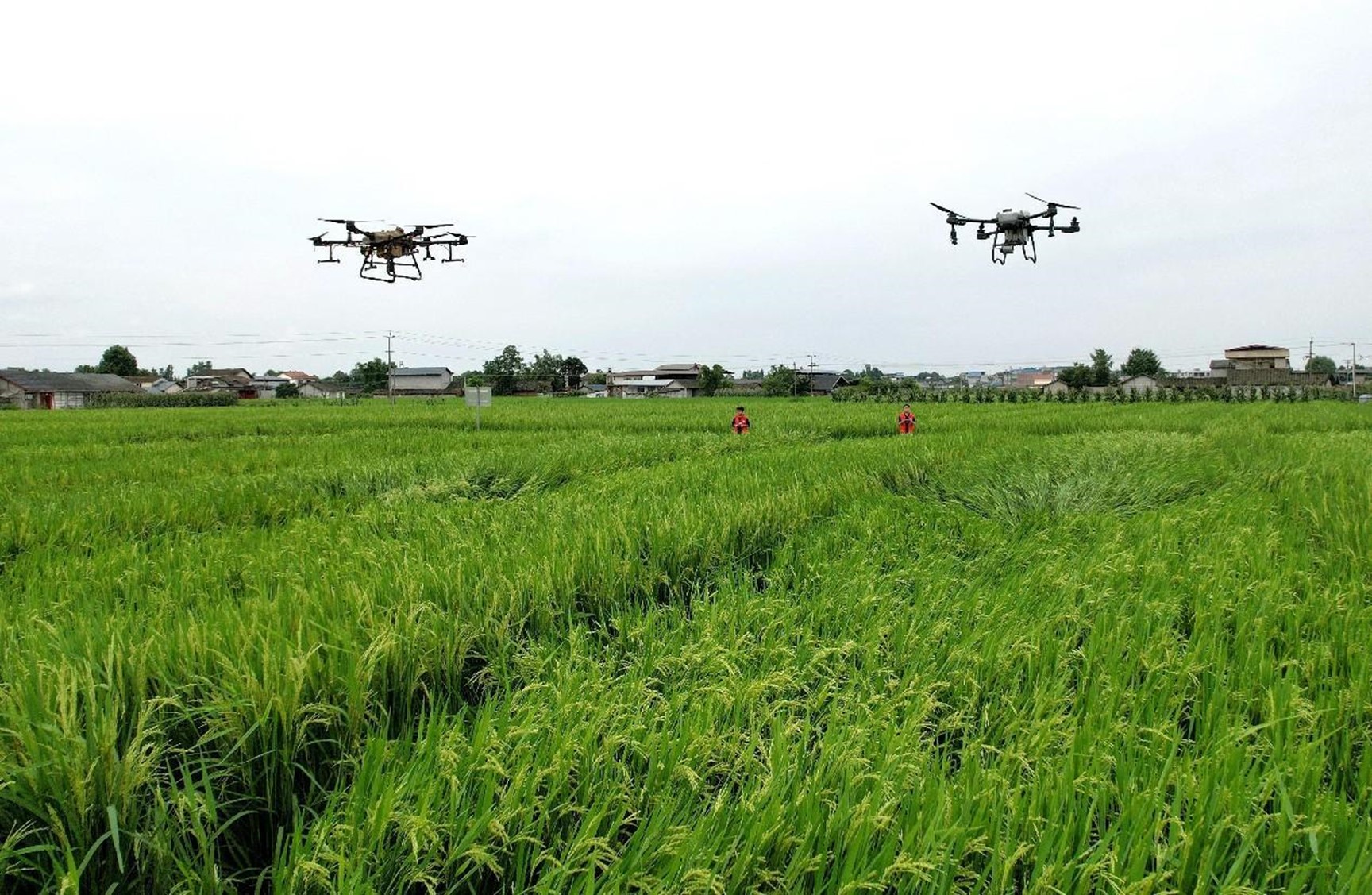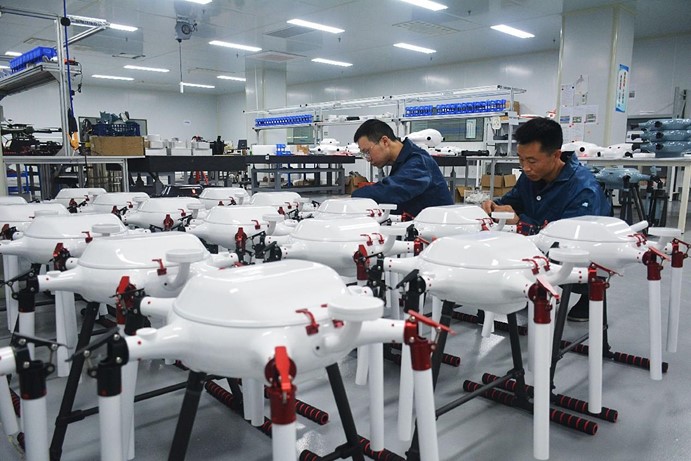Low-altitude economy widely applied across industries in China
In recent years, China's low-altitude economy has flourished, with applications continually expanding and becoming increasingly integrated into people's work and life.
Aviation operations such as agricultural and forestry protection and power line inspections have seen steady growth. New consumption models like air touring and aviation sports are rapidly emerging. Novel drone scenarios, including emergency rescue and meteorological detection, are being introduced one after another. Drone-based last-mile logistics delivery is being applied on a large scale.

Agricultural technicians operate drones to pollinate rice in a hybrid rice plantation in Tongsheng village, Heqing township, Mianyang, southwest China's Sichuan province. (People's Daily Online/Zhang Zuqiang)
Now, China is home to more than 14,000 drone companies holding valid civil unmanned aircraft operation certificates, while the number of licensed drone operators has surpassed 225,000 in the country.
In the first half of this year, nearly 608,000 new drones were registered, representing a 48 percent increase compared to the end of last year. The cumulative flight hours by drones exceeded 9.81 million, 134,000 hours more compared to the same period last year.
Gong Yang is a photography enthusiast from southwest China's Sichuan province who has been using drones for aerial photography for many years.
"These were all taken with my drones," he told People's Daily, pointing to photos of the clear and enchanting water of the Tuojiang River, as well as the steep cliffs reaching into the clouds of the Yunding Mountain.
"Photos I once had to climb a mountain to get can now be quickly captured by a drone, and the perspective is even more expansive," Gong said.
In his view, as drone products have become increasingly sophisticated, they've lowered both the equipment costs and technical barriers for aerial photography, attracting an increasing number of photography enthusiasts to make purchases.

Drones are manufactured in a workshop of an aerial technology company in Anqing, east China's Anhui province. (People's Daily Online/Wu Junqi)
In recent years, many regions have been encouraging the development of featured projects such as low-altitude flying, air touring, and aviation exhibitions to create more commercial opportunities.
Low-altitude aviation passenger transport has also become a regular service in multiple areas, with over 100 short-haul routes established. The peak annual passenger traffic has reached about 70,000, meeting specific transportation needs.
Qin Rui, a professor at the Civil Aviation University of China, believes that as relevant technologies are refined and more widely applied, low-altitude flight scenarios will see further expansion.
Beyond the consumer sector, the low-altitude economy is empowering numerous industries, seeing into logistics, agriculture, as well as surveying and mapping.
"It's even faster than I imagined!" exclaimed Zhang Xin, who works in Liangxi district of Wuxi, east China's Jiangsu province. He had just received a contract delivered by another company in the city's Xinwu district via a drone delivery service by SF Express.
Li Zhiyuan, head of SF Express's Baolong business unit in Xinwu district, told People's Daily that the drones mainly transport lightweight items such as documents, keys, and medicines. Compared to conventional delivery methods, direct drone delivery can save about half the time.
An official from the Civil Aviation Administration of China (CAAC) explained that in recent years, the CAAC has successively introduced relevant standards and regulations to facilitate the implementation of urban lightweight drone logistics applications.
The Suining hydrological and water resources survey center in Sichuan province has employed a multi-rotor drone to collect data on both banks of the Fujiang River.
According to Peng Jian with the survey center, drone operations cover a large survey area with minimal manpower and higher efficiency. Compared to traditional surveying methods, this approach can save about 2/3 of the cost.
"These image data will be used to build a digital base for a digital twin platform of the river basin, providing fundamental support for smart water conservancy operations," Peng explained.
"The low-altitude economy represents a deep integration of the real economy and the digital economy," said Wu Qihui, vice president of Nanjing University of Aeronautics and Astronautics.
"It not only directly serves agriculture, industry, and the service sector, but its production and innovative applications can also drive the development of industries such as new materials, finance, communication technology, and artificial intelligence, continuously spawning new industries, new professions, and new growth drivers," Wu noted.
Moreover, from emergency rescue and medical care to law enforcement, drones are being used in an increasing number of public management and service scenarios.

Employees of the drone center of the Huaibei branch of State Grid in east China's Anhui province join a training session of drone operation. (People's Daily Online/Wang Wen)
One evening, a patient with hemorrhagic shock was brought to the emergency room of Nanjing Pukou People's Hospital in Jiangsu province. After an emergency blood transfusion, the patient still required a large amount of blood for surgery. The hospital's blood transfusion department immediately contacted the Nanjing Red Cross Blood Center. With the evening rush hour causing traffic jams, how could timely delivery be ensured? The blood center promptly activated a "low-altitude blood delivery route". With a straight-line distance of nearly 15 kilometers, the drone delivered the blood to the hospital in just 16 minutes.
An official with CAAC told People's Daily that in recent years, 32 flight service stations at provincial and municipal levels have been established, and "green channels" for flight plan approvals under special circumstances such as emergencies, disaster relief, and rescue operations have also been opened, further improving the support system for low-altitude flight services.
Photos
Related Stories
- China's drone industry reports rapid growth in H1
- Chengdu speeds up development of low-altitude economy
- Low-altitude economy poised for takeoff
- Chinese cities speed up low-altitude economy, a new force driving development
- Come to China for an exciting low-altitude adventure
- Low-altitude economy takes off in China
- China's technology companies provide aerial vehicle products, solutions for many industries
- Shenyang provides solid foundation for development of low-altitude economy
- Hainan's low-altitude economy soaring high
- Low-altitude economy soars as new growth engine in Wuhu, E China’s Anhui
Copyright © 2024 People's Daily Online. All Rights Reserved.









